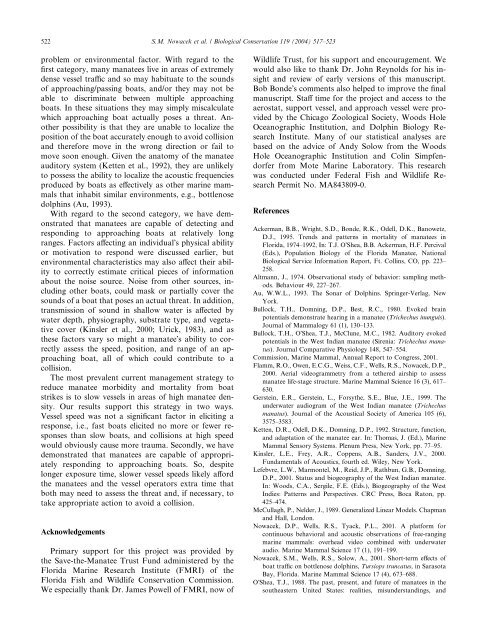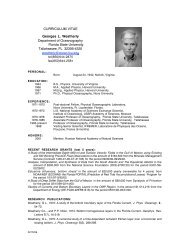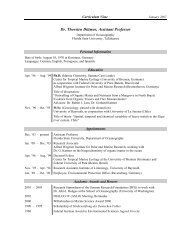Florida manatees, Trichechus manatus latirostris, respond to ...
Florida manatees, Trichechus manatus latirostris, respond to ...
Florida manatees, Trichechus manatus latirostris, respond to ...
You also want an ePaper? Increase the reach of your titles
YUMPU automatically turns print PDFs into web optimized ePapers that Google loves.
522 S.M. Nowacek et al. / Biological Conservation 119 (2004) 517–523<br />
problem or environmental fac<strong>to</strong>r. With regard <strong>to</strong> the<br />
first category, many <strong>manatees</strong> live in areas of extremely<br />
dense vessel traffic and so may habituate <strong>to</strong> the sounds<br />
of approaching/passing boats, and/or they may not be<br />
able <strong>to</strong> discriminate between multiple approaching<br />
boats. In these situations they may simply miscalculate<br />
which approaching boat actually poses a threat. Another<br />
possibility is that they are unable <strong>to</strong> localize the<br />
position of the boat accurately enough <strong>to</strong> avoid collision<br />
and therefore move in the wrong direction or fail <strong>to</strong><br />
move soon enough. Given the ana<strong>to</strong>my of the manatee<br />
audi<strong>to</strong>ry system (Ketten et al., 1992), they are unlikely<br />
<strong>to</strong> possess the ability <strong>to</strong> localize the acoustic frequencies<br />
produced by boats as effectively as other marine mammals<br />
that inhabit similar environments, e.g., bottlenose<br />
dolphins (Au, 1993).<br />
With regard <strong>to</strong> the second category, we have demonstrated<br />
that <strong>manatees</strong> are capable of detecting and<br />
<strong>respond</strong>ing <strong>to</strong> approaching boats at relatively long<br />
ranges. Fac<strong>to</strong>rs affecting an individualÕs physical ability<br />
or motivation <strong>to</strong> <strong>respond</strong> were discussed earlier, but<br />
environmental characteristics may also affect their ability<br />
<strong>to</strong> correctly estimate critical pieces of information<br />
about the noise source. Noise from other sources, including<br />
other boats, could mask or partially cover the<br />
sounds of a boat that poses an actual threat. In addition,<br />
transmission of sound in shallow water is affected by<br />
water depth, physiography, substrate type, and vegetative<br />
cover (Kinsler et al., 2000; Urick, 1983), and as<br />
these fac<strong>to</strong>rs vary so might a manateeÕs ability <strong>to</strong> correctly<br />
assess the speed, position, and range of an approaching<br />
boat, all of which could contribute <strong>to</strong> a<br />
collision.<br />
The most prevalent current management strategy <strong>to</strong><br />
reduce manatee morbidity and mortality from boat<br />
strikes is <strong>to</strong> slow vessels in areas of high manatee density.<br />
Our results support this strategy in two ways.<br />
Vessel speed was not a significant fac<strong>to</strong>r in eliciting a<br />
response, i.e., fast boats elicited no more or fewer responses<br />
than slow boats, and collisions at high speed<br />
would obviously cause more trauma. Secondly, we have<br />
demonstrated that <strong>manatees</strong> are capable of appropriately<br />
<strong>respond</strong>ing <strong>to</strong> approaching boats. So, despite<br />
longer exposure time, slower vessel speeds likely afford<br />
the <strong>manatees</strong> and the vessel opera<strong>to</strong>rs extra time that<br />
both may need <strong>to</strong> assess the threat and, if necessary, <strong>to</strong><br />
take appropriate action <strong>to</strong> avoid a collision.<br />
Acknowledgements<br />
Primary support for this project was provided by<br />
the Save-the-Manatee Trust Fund administered by the<br />
<strong>Florida</strong> Marine Research Institute (FMRI) of the<br />
<strong>Florida</strong> Fish and Wildlife Conservation Commission.<br />
We especially thank Dr. James Powell of FMRI, now of<br />
Wildlife Trust, for his support and encouragement. We<br />
would also like <strong>to</strong> thank Dr. John Reynolds for his insight<br />
and review of early versions of this manuscript.<br />
Bob BondeÕs comments also helped <strong>to</strong> improve the final<br />
manuscript. Staff time for the project and access <strong>to</strong> the<br />
aerostat, support vessel, and approach vessel were provided<br />
by the Chicago Zoological Society, Woods Hole<br />
Oceanographic Institution, and Dolphin Biology Research<br />
Institute. Many of our statistical analyses are<br />
based on the advice of Andy Solow from the Woods<br />
Hole Oceanographic Institution and Colin Simpfendorfer<br />
from Mote Marine Labora<strong>to</strong>ry. This research<br />
was conducted under Federal Fish and Wildlife Research<br />
Permit No. MA843809-0.<br />
References<br />
Ackerman, B.B., Wright, S.D., Bonde, R.K., Odell, D.K., Banowetz,<br />
D.J., 1995. Trends and patterns in mortality of <strong>manatees</strong> in<br />
<strong>Florida</strong>, 1974–1992, In: T.J. OÕShea, B.B. Ackerman, H.F. Percival<br />
(Eds.), Population Biology of the <strong>Florida</strong> Manatee, National<br />
Biological Service Information Report, Ft. Collins, CO, pp. 223–<br />
258.<br />
Altmann, J., 1974. Observational study of behavior: sampling methods.<br />
Behaviour 49, 227–267.<br />
Au, W.W.L., 1993. The Sonar of Dolphins. Springer-Verlag, New<br />
York.<br />
Bullock, T.H., Domning, D.P., Best, R.C., 1980. Evoked brain<br />
potentials demonstrate hearing in a manatee (<strong>Trichechus</strong> inunguis).<br />
Journal of Mammalogy 61 (1), 130–133.<br />
Bullock, T.H., OÕShea, T.J., McClune, M.C., 1982. Audi<strong>to</strong>ry evoked<br />
potentials in the West Indian manatee (Sirenia: <strong>Trichechus</strong> <strong>manatus</strong>).<br />
Journal Comparative Physiology 148, 547–554.<br />
Commission, Marine Mammal, Annual Report <strong>to</strong> Congress, 2001.<br />
Flamm, R.O., Owen, E.C.G., Weiss, C.F., Wells, R.S., Nowacek, D.P.,<br />
2000. Aerial videogrammetry from a tethered airship <strong>to</strong> assess<br />
manatee life-stage structure. Marine Mammal Science 16 (3), 617–<br />
630.<br />
Gerstein, E.R., Gerstein, L., Forsythe, S.E., Blue, J.E., 1999. The<br />
underwater audiogram of the West Indian manatee (<strong>Trichechus</strong><br />
<strong>manatus</strong>). Journal of the Acoustical Society of America 105 (6),<br />
3575–3583.<br />
Ketten, D.R., Odell, D.K., Domning, D.P., 1992. Structure, function,<br />
and adaptation of the manatee ear. In: Thomas, J. (Ed.), Marine<br />
Mammal Sensory Systems. Plenum Press, New York, pp. 77–95.<br />
Kinsler, L.E., Frey, A.R., Coppens, A.B., Sanders, J.V., 2000.<br />
Fundamentals of Acoustics, fourth ed. Wiley, New York.<br />
Lefebvre, L.W., Marmontel, M., Reid, J.P., Rathbun, G.B., Domning,<br />
D.P., 2001. Status and biogeography of the West Indian manatee.<br />
In: Woods, C.A., Sergile, F.E. (Eds.), Biogeography of the West<br />
Indies: Patterns and Perspectives. CRC Press, Boca Ra<strong>to</strong>n, pp.<br />
425–474.<br />
McCullagh, P., Nelder, J., 1989. Generalized Linear Models. Chapman<br />
and Hall, London.<br />
Nowacek, D.P., Wells, R.S., Tyack, P.L., 2001. A platform for<br />
continuous behavioral and acoustic observations of free-ranging<br />
marine mammals: overhead video combined with underwater<br />
audio. Marine Mammal Science 17 (1), 191–199.<br />
Nowacek, S.M., Wells, R.S., Solow, A., 2001. Short-term effects of<br />
boat traffic on bottlenose dolphins, Tursiops truncatus, in Sarasota<br />
Bay, <strong>Florida</strong>. Marine Mammal Science 17 (4), 673–688.<br />
OÕShea, T.J., 1988. The past, present, and future of <strong>manatees</strong> in the<br />
southeastern United States: realities, misunderstandings, and




